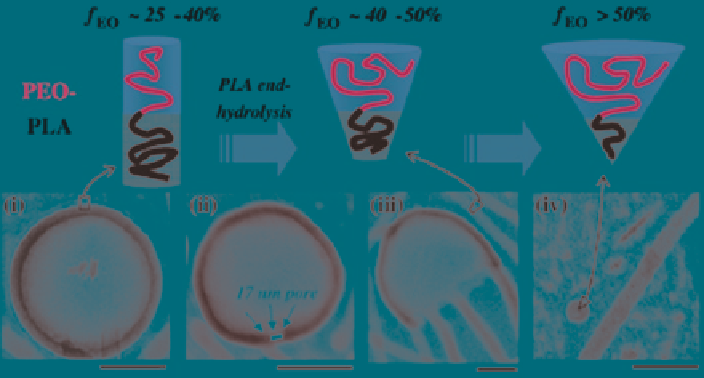Biomedical Engineering Reference
In-Depth Information
Fig. 1
Representative time series showing the breakdown structures formed as PEG-
b
-PLA
polymersomes transform from vesicles to worm-like micelles. The scale bars in the cryo-TEM
images are 100 nm. (Reproduced from ref. Ahmed et al.
2006
)
2.2
Response to Oxidation Reaction
Instead of hydrolyzing the hydrophobic polymer block, Hubbell and co-workers
changed the value of hydrophilic/hydrophobic ratio via oxidation of the hydropho-
bic block. This strategy could potentially exploit the oxidative environment present
in sites of inflammation as well as within endolysosomes. They developed oxidation-
responsive polymersomes from PEO-
b
-PPS-
b
-PEO (PPS: polypropylene sulphide)
triblock copolymers (Napoli et al.
2004a, b, 2005
), and showed that exposure to
either aqueous H
2
O
2
or H
2
O
2
from glucose-oxidase/glucose/oxygen system
oxidized the hydrophobic polypropylene sulphide layer, thereby transforming it
into hydrophilic poly(propylene sulphoxide) and poly(propylene sulphone).
Oxidation thus increased the hydrophilic percentage in the amphiphilic system,
thereby causing a transition from polymersomes to wormlike micelles, spherical
micelles, and eventually soluble oxidized copolymers. This transition took about
10 h in 10-vol%H
2
O
2
aqueous solution and around 300 h in 0.03-vol% H
2
O
2
. These
oxidation-responsive polymersomes may find applications as nanocontainers in
drug delivery, biosensing and biodetection.
2.3
Response to Reduction Reaction
Reduction-sensitive materials containing disulphide bonds have been used to
produce reduction-responsive polymersomes. Hubbell and co-workers recently
reported polymersomes based on diblock copolymers PEG-SS-PPS, where a

Search WWH ::

Custom Search